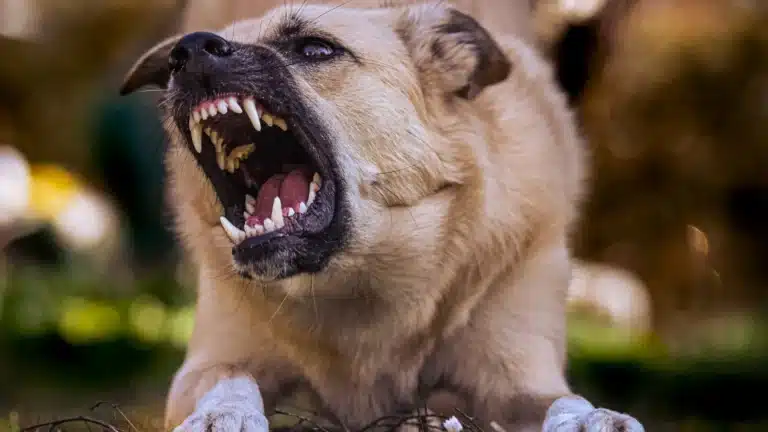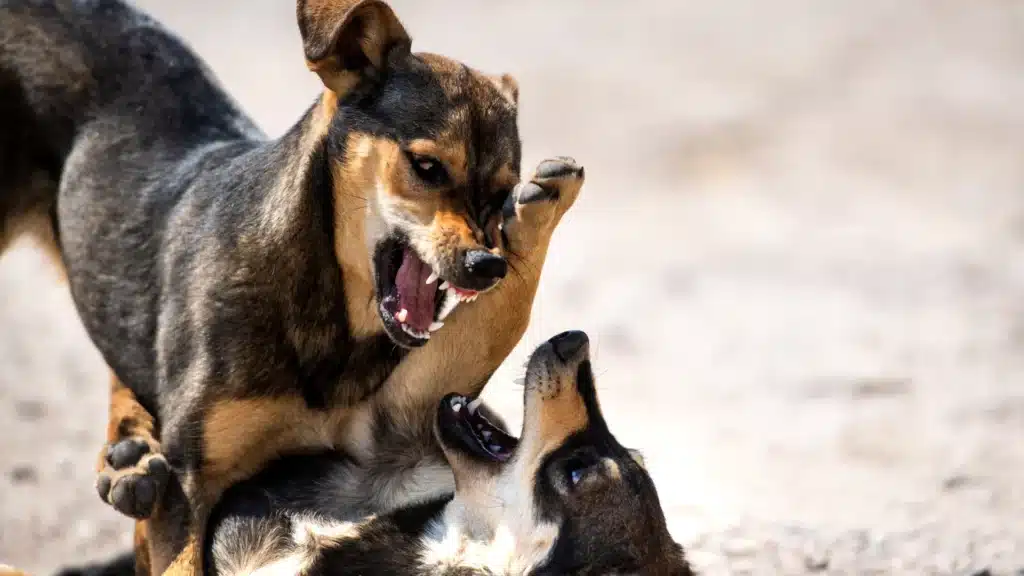First Signs of Dog Aggression: A Comprehensive Guide
Dogs are great companions known for their loyalty and playfulness and can sometimes show signs of aggressive behaviour. Noticing these early signs of aggression in dogs is important for the safety of humans and animals. Whether you’re a dog owner, trainer, veterinarian, or animal behaviourist, understanding aggression can help prevent dangerous situations and promote a happier, more balanced relationship with your furry friend.

What Is Dog Aggression?
Aggression in dogs refers to any behaviour intended to threaten, intimidate, or cause harm to another animal or person. This can include growling, barking, snapping, lunging, or biting. While some forms of aggression may seem minor, like a warning growl when a dog is startled or others can be more serious and require immediate attention.
Aggressive behaviours can lead to injuries, fear-based reactions, or even legal consequences for dog owners. The key to handling aggression is understanding its root causes and responding before it escalates.
Here are some common types of dog aggression:
Fear-Based Aggression:
- Lack of Socialization
- Dogs that are not introduced to different people, places, and situations during puppyhood may grow up fearful of new experiences.
- A well socialized dog is more likely to feel comfortable and confident in unfamiliar situations.
- Lack of Socialization
- Poor Training Methods
- Cruel training methods, such as yelling, hitting, or punishment-based techniques, can make a dog fearful or defensive.
- Positive reinforcement (rewarding good behaviour) is a more effective way to train dogs and prevent aggression.
- Poor Training Methods
- Past Trauma or Abuse
- Flinching or cowering when approached
- Reacting aggressively to sudden movements or loud noises
- Avoiding eye contact or appearing overly submissive
- Dogs that have experienced neglect, abandonment, or physical abuse may be more reactive or aggressive, primarily if they associate people or specific actions with past pain.
- Rescue dogs with unknown histories may need extra patience and training to help them build trust again.
- Past Trauma or Abuse
Territorial and Protective Aggression:
- Some dogs instinctively protect their homes or yards.
- They might bark, lunge, or bite if they believe someone intrudes.
- Some territorial behaviour is normal, but excessive aggression toward guests or strangers requires training and management.
- Barking at the door, growling at guests, or snapping at another pet that gets too close to their space are all forms of territorial behaviour.
- Changes in Surroundings
- Dogs thrive on consistency, and sudden changes in their environment can make them feel stressed or insecure.
- Moving to a new home
- Rearranging furniture or adding new items to the house
- Loud noises from construction, fireworks, or thunderstorms
- Changes in family dynamics, such as a new baby or a roommate moving in
- When dogs feel uncertain or overwhelmed, they may respond with defensive or reactive behaviour.
- Being Protective
- Dogs instinctively protect their owners and family members.
- Dogs start to become aggressive toward people or animals and are viewed as threats, even when there is no real danger.
- Being Protective
Resource Guarding Aggression:
- Guarding food bowls, toys, or their favourite spots.
- A dog might growl, stiffen, or snap if someone approaches while they are eating or playing with a prized possession.
- Teaching a dog to feel comfortable with sharing and preventing resource guarding early can reduce these behaviours.
Pain-Induced Aggression:
- A dog may react aggressively when touched if injured or suffering from a medical condition.
- A dog who suddenly becomes aggressive may be in pain, so it’s always a good idea to consult a veterinarian if there is an unexplained change in behaviour.
- Dogs experiencing pain from injuries, arthritis, dental problems, or infections may react aggressively when touched.
- Some medical conditions, such as brain tumours, epilepsy, or cognitive dysfunction in older dogs, can cause sudden personality changes, including aggression.
- Thyroid disorders can also lead to irritability and aggression.
- Hormonal Imbalances
- Hormones play a significant role in a dog’s mood and behaviour.
- Unneutered male dogs may show more dominant or aggressive tendencies, especially around other males.
- Hormonal Imbalances
Social Aggression:
- Dogs, like wolves, have a social order.
- Some dogs may act aggressively towards others to show they are dominant. While this behaviour can sometimes be normal, too much aggression in social situations should be addressed with extra training and Socialization.
- New People or Animals
- Some dogs are naturally wary of strangers, and introducing new people or animals into their space can make them feel defensive.
- A dog might react aggressively if they perceive a new person as a threat, especially if it approaches too quickly or invades the dog’s personal space.
- Dogs not socialized with other animals may show territorial or fear based aggression when they meet unfamiliar pets.
- A stranger approaches too quickly.
- A new pet is introduced into the home.
- A dog feels their owner’s attention is being taken away by someone else.
- New People or Animals
Common Misconceptions About Dog Aggression
Many myths about dog aggression can create unnecessary fear and lead to harmful behaviour toward dogs. Sometimes, these misunderstandings can cloud our judgement of how dogs act and interact. Correcting these myths to better understand dog’s behaviour and motivations is important. By learning about the true nature of dogs and their signals, we can create a safer and more positive environment for dogs and the people who meet them.
Aggressive Dogs Are “Bad” Dogs
Aggression is a behaviour, not a personality trait. Many aggressive dogs act this way because they are scared, in pain, or have had bad experiences in the past. Most aggressive dogs can improve with proper training, patience, and sometimes professional help.
Certain Breeds Are Naturally Aggressive
While some breeds may have stronger protective instincts or energy levels, no breed is born aggressive. A dog’s environment, training, and Socialization play a far bigger role in their behaviour than genetics alone.
Growling Means a Dog Will Always Bite
Growling usually indicates a dog feeling uncomfortable or scared rather than posing an immediate threat. Dogs use growling to communicate these feelings. Instead of punishing a dog for growling, it’s best to understand and address what is causing it.
Aggressive Dogs Cannot Be Trained
The proper training and environment can manage and improve most aggressive behaviours. Even dogs that have been aggressive can learn to cope better with positive reinforcement and patience.
Recognizing the First Signs of Aggression in Dogs
The best way to prevent aggression from escalating is to recognize the early warning signs. Dogs typically show signs of discomfort before they bite or attack. Some common early signs include:
Body Language and Posture:
A dog’s body language provides one of the earliest and most reliable signs of their emotional state. Even before a dog growls or snaps, subtle changes in posture, tail position, and facial expressions can signal discomfort or aggression.
- Tail Position
- Neutral or relaxed tail: A comfortable dog will have a relaxed or gently wagging tail.
- Stiff, high tail: When a dog holds its tail high and rigid, it often signals dominance, alertness, or potential aggression.
- Tucked tail: A tail tucked between their legs is a sign of fear or submission, but if the dog feels trapped, fear can quickly turn into aggression.
- Tail Position
-
- Ear Position:
- Forward-facing ears: A dog’s curious or excited behaviour can mean they are paying attention and preparing to react.
- Pinned-back ears: When a dog’s ears are pulled back against its head, it usually means the dog feels scared or threatened.
- Ear Position:
-
- Stance and Posture
- Rigid body – A stiff, tense body is often a sign that a dog feels defensive or ready to react.
- Leaning forward – A dog that shifts its weight forward may be preparing to lunge or attack.
- Cowering or retreating – A fearful dog may lower its body to the ground or try to move away. Still, if they feel cornered, they may respond aggressively.
- Stance and Posture
- Facial Expressions and Eye Contact
- Direct staring – In the dog world, staring at a dog for a long time can be a challenge or a sign of dominance.
- Hard, narrowed eyes – If a dog’s eyes appear fixed and intense, it may be feeling threatened or ready to act aggressively.
- Lip licking or yawning – While these may seem harmless, they are often signs of stress or discomfort in dogs.
- Facial Expressions and Eye Contact
Vocalizations and Sounds:
Dogs use vocal signals to communicate their emotions, and different sounds can indicate different levels of discomfort or aggression.
- Growling
- A low, rumbling growl is a warning that a dog feels threatened or uncomfortable and is a sign to take it seriously.
- Growling
- Barking
- Short, sharp barks can be a sign of alertness or warning.
- Continuous, deep barking can indicate territorial aggression.
- High-pitched, frantic barking may be a sign of fear or anxiety.
- Barking
- Snarling
- Snarling (growling while baring teeth) is a serious warning that a dog is ready to escalate its aggression.
- This often happens if a dog feels the need to protect itself, its food, or its territory.
- Whining or Whimpering
- While not related to aggression, whining can indicate frustration or discomfort, leading to reactive behaviours if ignored.
- Whining or Whimpering
Behavioural Changes:
Besides body language and vocal cues, changes in a dog’s routine behaviour can also signal the early stages of aggression. These changes are often subtle initially but can become more noticeable over time.
- Sudden Mood or Routine Changes
- A friendly, social dog who suddenly becomes withdrawn or irritable may be experiencing discomfort, anxiety, or medical issues.
- Changes in appetite, sleep patterns, or interaction levels can indicate something is wrong.
- Sudden Mood or Routine Changes
- Uncharacteristic Actions
- Snapping or lunging: This is a strong warning sign if a dog suddenly starts snapping at people or other animals without clear provocation.
- Guarding behaviour: A dog that becomes overly possessive of food, toys, or spaces may growl or snap when approached.
- Excessive licking or self-chewing: While this may not seem aggressive, excessive self-grooming can signify stress or frustration.
How to Prevent and Manage Aggressive Behavior
Early detection of aggression allows dog owners and trainers to intervene before behaviour worsens. Addressing the underlying cause, whether fear, pain, or territorial instincts. Dogs can be trained to react differently and feel more secure in their environment.
Stay calm: Dogs can sense how humans feel. If you show fear or frustration, it may make things worse. Use a calm, steady voice and avoid sudden movements.
Remove triggers: Pay attention to what situations cause your dog to react aggressively. Is it new people? Loud noises? Other animals?
Avoid punishment: Never try to physically punish or challenge an aggressive dog. This can increase fear and make the aggression worse.
Seek veterinarian help: A veterinarian can help rule out pain or illness.
Provide Socialization: Exposing your dog to different environments, people, and animals in a positive way can help them feel more comfortable.
Positive Reinforcement: Use reward based training to encourage good behaviour rather than punish bad behaviour. Once your dog starts to relax, reward them for calm behaviour. A quiet “good boy/girl” and a small treat can reinforce positive reactions. Over time, this helps them associate calm behaviour with rewards.
Consult a Professional Trainer: If a dog has a history of trauma, work with a professional trainer or behaviourist to build their confidence and reduce fear-based aggression.
Give Your Dog Space: Avoid cornering them if your dog shows signs of aggression. Instead, allow them an escape route to reduce their stress.
Youtube Training Resource:
Practical Tips:
- What should I do if my dog starts acting aggressively?
- Dogs can sense fear or frustration, which can make them more reactive.
- Move away from the trigger if possible.
- Yelling or hitting can increase aggression and fear.
- Redirect your dog’s attention with a treat, toy, or command.
- If your dog is feeling overwhelmed, let them calm down before approaching again.
- How do I stop my dog from resource guarding (food, toys, etc.)?
- Don’t take items away suddenly—this can make them more protective.
- Teach “trade” by offering a high-value treat in exchange for the guarded item.
- Gradually desensitize them by being near their food or toys while rewarding calm behaviour.
- How can I prevent aggression toward strangers?
- Expose your dog to new people gradually and in a controlled way.
- Let your dog approach at their own pace instead of forcing interactions.
- Reward friendly behaviour with treats and praise.
- Avoid overwhelming situations with too many new faces at once.
- How do I manage leash aggression?
- Use a front-clip harness for better control.
- Keep a safe distance from other dogs at first.
- Reward calm behaviour and slowly reduce the distance over time.
- Do not pull on the leash, as this can create more tension.

Resources for Further Support
If you’re dealing with dog aggression and need extra help, here are some trusted resources:
1. Professional Help
Certified Dog Trainers: Find trainers who use positive reinforcement techniques through organizations like:
Veterinarians and Animal Behaviorists:
- If aggression is sudden, a vet visit can rule out medical issues.
- A veterinary behaviourist specializes in diagnosing and treating serious behavioural problems.
2. Books on Dog Behaviour:
- The Other End of the Leash – Patricia McConnell
Explains how human behaviour influences a dog’s reactions and offers training techniques based on communication and mutual respect. - Mine! A Practical Guide to Resource Guarding in Dogs – Jean Donaldson
A must-read for anyone dealing with resource guarding (aggression over food, toys, or space). Provides step-by-step solutions for managing and reducing guarding behaviours. - Calming Signals: What Your Dog Tells You – Turid Rugaas
Focuses on understanding canine body language and “calming signals” that dogs use to communicate discomfort before aggression occurs. - Aggression in Dogs: Practical Management, Prevention & Behavior Modification – Brenda Aloff
A comprehensive guide for trainers and owners who manage aggressive behaviours with effective strategies. - Behavior Adjustment Training 2.0: New Practical Techniques for Fear, Frustration, and Aggression in Dogs – Grisha Stewart
Introduces positive reinforcement and desensitization techniques to help dogs develop confidence and reduce reactivity.
- The Other End of the Leash – Patricia McConnell
3. Online Forums:
- Dog Behavior and Training (Positive Reinforcement Focused)
A group dedicated to force-free, science-based training methods. Visit here
- Pet Forums – Dog Training and Behavior Section
A forum where dog owners can discuss training and behaviour issues. Visit here
- Dog Behavior and Training (Positive Reinforcement Focused)
4. Ceritified Dog Trainers and Behaviorists
- The Association of Professional Dog Trainers (APDT)
It offers a searchable directory of certified trainers who use humane, science-based methods. Find a trainer here - International Association of Animal Behavior Consultants (IAABC)
Provides a list of qualified animal behaviour consultants specializing in aggression and other behavioural issues. Visit here - The American College of Veterinary Behaviorists (ACVB)
Connects dog owners with veterinarians who specialize in behaviour issues, including aggression. Find a veterinary behaviourist - The Certification Council for Professional Dog Trainers (CCPDT)
Lists certified trainers who follow ethical, force-free training methods. Search for a trainer - Fear Free Happy Homes
Provides resources and certified professionals trained in fear-free training and veterinary care. Visit here
- The Association of Professional Dog Trainers (APDT)
Every dog can improve with patience, training, and care. Understanding dog aggression is important to keep both dogs and people safe. You can help prevent negative behaviours from worsening by identifying the different types of aggression, sorting facts from myths, and recognizing early warning signs. With the right approach, aggressive dogs can become well-adjusted and happy companions.
